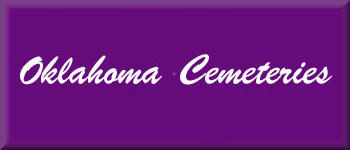


 |
 |  |
THE TOWN OF PARKLAND, OKLAHOMA
Troy was the original name given the settlement now known as Parkland, located in the NE 1/4 of the NE 1/4 of Section 26, Township 16 north, Range 4 east in Lincoln County. It was then surveyed and laid off for the town site in 1894.The company of four men - C. H. Cannon, J. R. Means, O. H. Spice, and Manley Thomas formed a group with legal papers, granted from the territory office in Guthrie, and chose to name the town of Parkland. The total price paid for the townsite by the company was $1000.00. The forty acres were divided into lots which sold quickly to people for homes and businesses to be built.Some of the earliest places of business were dry goods and grocery stores, cotton gin, drug store, doctor's office, barber shop, pool hall and saloon, bank, blacksmith shop, public school, and a cemetery plot, which was bought from Elijah and Nancy Peyton. The cemetery plot consisted of four acres, purchased November 2, 1895, for the sum of $48.00. Since then, a gift of land joining on the west was part of land owned by Elmo E. Howard and his sister, Bonnie Howard Herrmann. The community has always taken great pride in its cemetery, which is one mile north of the townsite, and it is one of the best kept cemeteries in Lincoln County. One church is still very active in the town. The meeting house for the Church of the Firstborn is still located next to the school house. The building which housed the school is now used as a community center. A group of Methodists met in homes for worship and the Baptists also had a congregation in Parkland. Many people were baptized in the gin pond at the edge of town.The last school was a two room frame building. The land for it was donated by Porter Miller from his homestead, which lay north of the town site. The house in which he raised his three children, Arthur, Blanche and Everett is still standing.Dr. Elmer E. Lumm was one of the first doctors to locate in Parkland. He drove a horse and buggy many miles over roads and trails. He carried a pick and shovel, a crowbar and other tools to help make the trails more passable. He left Parkland in 1898, moving his drug store to Stroud, and setting up his practice of medicine there. Dr. Lumm bought one of the first Model T Fords in Stroud about 1910.Another doctor by the name of Davis practiced in Parkland for a short time and then moved on to Kendrick.About this same time, surveyors began planning the routes for railroads through the territory, and it turned out one railway was to go south from Cushing from what was soon to become Avery and on to what is now Kendrick. Another railroad was being built in 1897-1898 from Sapulpa to Oklahoma City, which would pass through Stroud, so Parkland was not to have rail service. Business people began making plans to obtain lots in Avery and Kendrick. The cotton gin was moved to Kendrick. Lots were offered free to some of the businesses in Parkland if they would move to Kendrick and among those who did were Seward Bishop's store, and Al Jorns' store. Porter Miller did not move his store away, as this was also the sight of the post office. The stone building is still standing today.The town of Parkland did not continue to grow as far as businesses coming in, as everything would either need to be hauled in from the nearest rail line at Kendrick or Avery. Some men hauled their supplies from Guthrie, which took 3-4 days for a round trip.There are still several residents in Parkland, even though there are no stores at the present time. Most of the people do their shopping in Chandler, Agra, and Cushing.© Lincoln County Oklahoma History, pages 177-178.
Submitted by Rosa Kemp Hicks 1988.
THE HISTORY OF PARKLAND, OKLAHOMA
Toward the north part of Lincoln County stands the little village of Parkland, very much as it was seventy years ago when the county was opened for settlement. The same two or three room houses still stand, but the first business buildings are gone with the exception of one old stone building which in the early days was a busy drug store, ran by McDowell and Braniger. It is now used for the storage of hay and grain.The original merchants were enterprising men and women. Besides the store just mentioned, there were grocery stores, one owned and operated by Levi Bolton, where Mrs. Clifford George, formerly Edna Bolton grew up. A few years later, Artie Miller and his father had a general store which did a big business. The Seward Bishop family operated another general store. Here Florence Bishop, later the wife of Dr. Hancock of Chandler, spent her childhood. Florence had her own little business in the store, where she made and sold doll clothes and hats. There were several other stores, for the trade territory was large, and included much of the north part of the county. One of the earliest families were the Fishbacks who also ran a store until the family was stricken by scarlet fever, at a time when scarlet fever sometimes meant death.The town boasted of two doctors, by the name of Will and Sim Davis, who later moved to Chandler. The doctors also served as dentists.In pioneer days, Parkland had its busy and wonderful Saturdays. There were no telephones and of course, no radios. A trip to the village of getting the neighborhood news and telling what you knew to others. In Parkland, the families would come in wagons or buggies or on horseback to spend the day, perhaps with a large hamper of food or an invitation to eat with friends.Parkland was so named because it was just that, "Park Land". Just east of the town there was a natural park with huge trees and grassy spaces. It was a perfect place for picnics which were enjoyed on every occasion possible such as Decoration Day, 4th of July and Sunday School picnics with every family coming with baskets of food.In the center of the park there was a large platform for dancing and where the Seabas were much in evidence. The platform would creak and groan with the weight of the dancers with the fiddlers furnishing the music and with someone to call the dances. It was a wonderful way for a boy to meet a girl.Nearby was the gin. It is another building which has withstood the onslaught of time for it is still there. The old school building has been replaced by a modern building, for Parkland is one country school which has been able to keep its identity through the years. The school has two teachers who this year are Mrs. John Kal and Mrs. Orin Stipe. The school has hot school lunches for the children and is equipped with many conveniences. Nearby stands a remodeled church building for though the pioneer families have moved to other locations which have the benefit of paved roads and highways, others have moved in who like the little village and continue to stay.The streets of Parkland never have known the advantage of paving but are just country roads, but passable.Not many small inland villages have survived but Parkland can boast that it is still on the map. It now has a general store and filling station, which is run by the only merchant in town, the Buddy Bakers. With a modern school with large attendance and a church building, modern Parkland seems destined to be here for several more generations.© Lincoln County Oklahoma History page 176-177.Written by Mamie Nixon 1988.
PARKLAND SCHOOL DISTRICT NO. 28
Parkland School District No. 28 land was donated to the town of Parkland by Porter Miller. The school started out as a one room school. There was a coal house. The school house was heated in winter with coal in a big pot bellied stove.There were two outhouses - - one for the boys and one for the girls.Parkland School District No. 28 was annexed to Agra, June 29, 1968.The teachers were: Deli Irvine, 1910-1912; Alta Biles, 1910-1912; J. J. and Beulah Blake, 1912-1913; Robert Biles, 1913-1914; Deli Irvine, 1914-1915; Mary Brock, 1914-1915; James Staten, 1915-1916; Lucy Fish, 1915-1916; Lula Anderson, 1916-1917; Pearl Powell, 1917-1918; Maggie Powell, 1918-1919; Bertha Staten, 1919-1920; Hi Staten, 1918-1921; Anna Staten, 1918-1919; Lucille Baird, 1920-1921; Ova Ward, 1920-1921; Nola Anderson, 1921-1922; Georgia Powell, 1921-1922; Ruth Taylor, 1920-1923; Zelma Taylor, 1922-1923; W. R. Adams, 1924-1925; Ola B. Powell, who taught from 1924-1954; Glen Staten, 1928-1929; Viola Mayes, 1929-1939; Daisy Palmer Blakley and Grace Holcomb, 1929-1933; Edna Laural Gower, 1930-1931; Louis Staten, 1931; Mary West, Florence Evans, Ruth Gallaher and Helen Johnson.© Lincoln County Oklahoma History, page 179.Submitted by Bonnie Howard Herrmann 1988.
PARKLAND CHURCH OF THE FIRSTBORN
They were called, Followers of Christ or True Followers by some of the people that lived around them.They came west in the early 1800's settling in Kansas, and when the land was opened up for settlement, they came to Stillwater, Oklahoma. Then moving on to the Parkland area in the early 1900's.They believe the church came into existence on the day of Pentecost.They believe also that God requires the same obedience to His word today as then.Some of the older ministers were: Bro. John Toles; Bro. Marion Reese; Bro. Monroe Testerman; Bro. Jim Tanksley and Bro. Eli Bridge.© Lincoln County Oklahoma History, page 177.
|Parkland Cemetery| |Lincoln County Cemeteries| |Home|
This site may be freely linked, but not duplicated in any way without consent.
All rights reserved! Commercial use of material within this site is prohibited!
© 2000-2024 Oklahoma CemeteriesThe information on this site is provided free for the purpose of researching your genealogy. This material may be freely used by non-commercial entities, for your own research, as long as this message remains on all copied material. The information contained in this site may not be copied to any other site without written "snail-mail" permission. If you wish to have a copy of a donor's material, you must have their permission. All information found on these pages is under copyright of Oklahoma Cemeteries. This is to protect any and all information donated. The original submitter or source of the information will retain their copyright. Unless otherwise stated, any donated material is given to Oklahoma Cemeteries to make it available online. This material will always be available at no cost, it will always remain free to the researcher.